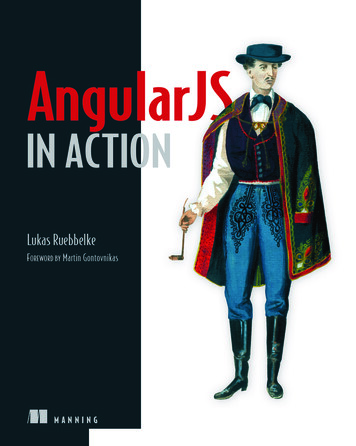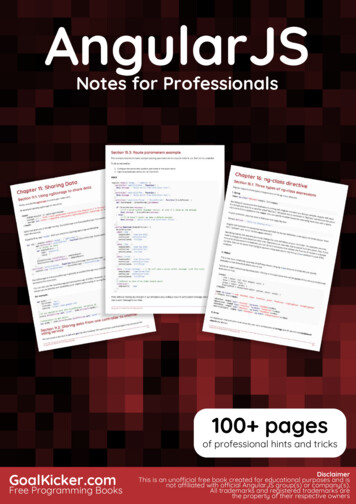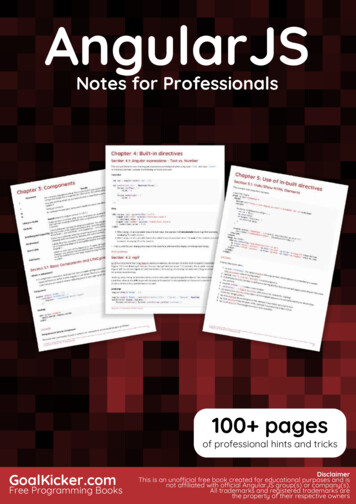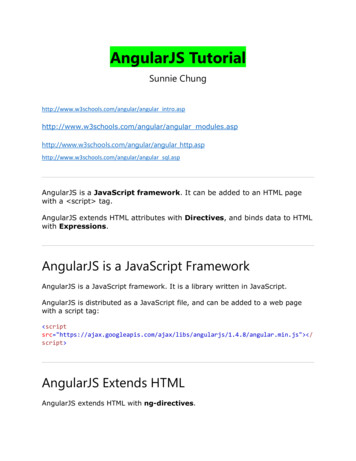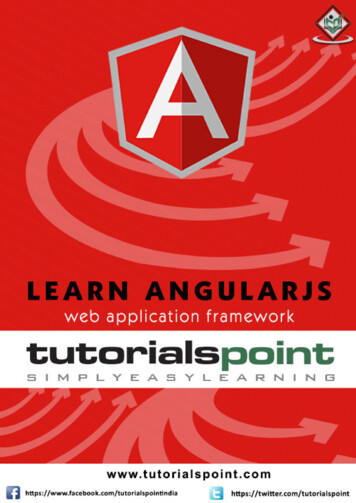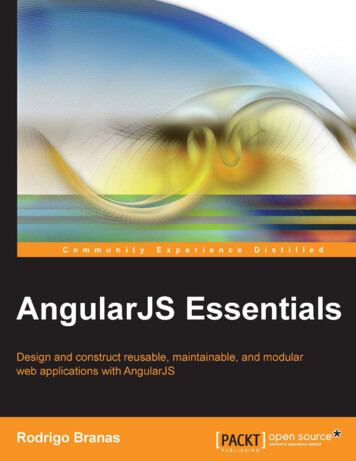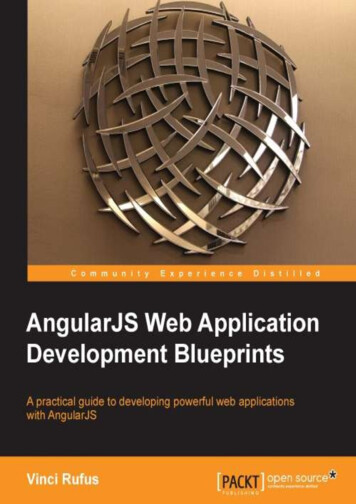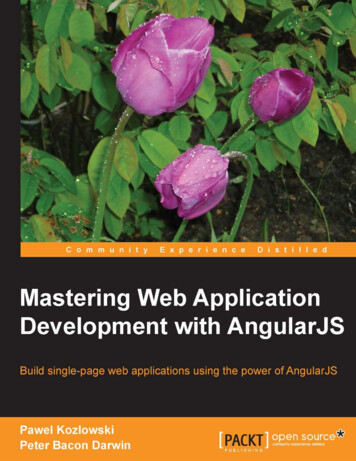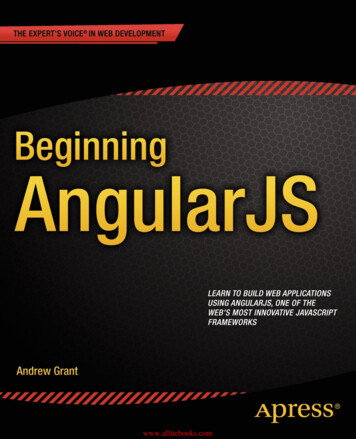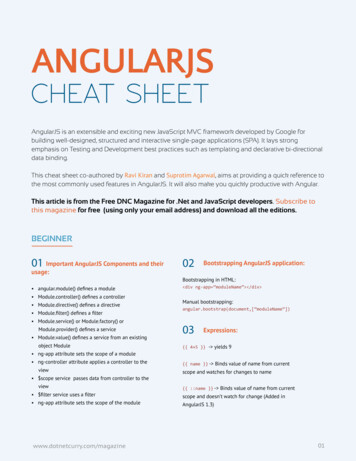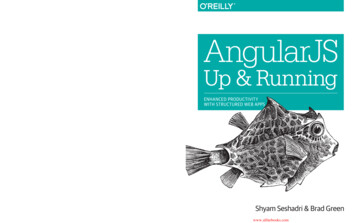
Transcription
AngularJS Up & RunningENHANCED PRODUCTIVITYWITH STRUCTURED WEB APPS Shyam Seshadri & Brad Greenwww.allitebooks.com
AngularJS: Up and RunningIf want to get started with AngularJS, either as a side project, an additionaltool, or for your main work, this practical guide teaches you how to use thismeta-framework step-by-step, from the basics to advanced concepts. Bythe end of the book, you’ll understand how to develop a large, maintainable,and performant application with AngularJS.Guided by two engineers who worked on AngularJS at Google, you’lllearn the components needed to build data-driven applications, usingdeclarative programming and the Model–view–controller pattern. You’llalso learn how to conduct unit tests on each part of your application. Learn how to use controllers for moving data to and from viewsUnderstand when to use AngularJS services instead ofcontrollersCommunicate with the server to store, fetch, and update dataasynchronouslyKnow when to use AngularJS ilters for converting data andvalues to diferent formatshardly more than“I'man amateur JavaScriptdeveloper and I had zeroproblems understandingthis book. I appreciatehow it started at thevery beginning—thewhy of AngularJS—andslowly worked its wayup from there. Thecomplimentary coderepository was a hugehelp as well!”—Marc Amosfrontend developerImplement single-page applications, using ngRoute to selectviews and navigationDive into basic and advanced directives for creating reusablecomponentsWrite an end-to-end test on a live version of your entireapplicationUse best practices, guidelines, and tools throughout thedevelopment cycleShyam Seshadri, owner/CEO of Fundoo Solutions in Mumbai, splits his timebetween working on innovative and exciting new products for the Indian markets, and consulting about and running workshops on AngularJS.Brad Green, an engineering manager at Google, works on the AngularJS projectand directs Accessibility as well as Support Engineering. Brad also worked on theearly mobile web at AvantGo, and founded and sold startups.PROGR AMMING/JAVA SCRIPTUS 39.99Twitter: @oreillymediafacebook.com/oreillyCAN 41.99ISBN: 978-1-491-90194-6www.allitebooks.com
AngularJS: Up And RunningShyam Seshadri and Brad Greenwww.allitebooks.com
AngularJS: Up And Runningby Shyam Seshadri and Brad GreenCopyright 2014 Shyam Seshadri and Brad Green. All rights reserved.Printed in the United States of America.Published by O’Reilly Media, Inc., 1005 Gravenstein Highway North, Sebastopol, CA 95472.O’Reilly books may be purchased for educational, business, or sales promotional use. Online editions arealso available for most titles (http://safaribooksonline.com). For more information, contact our corporate/institutional sales department: 800-998-9938 or corporate@oreilly.com.Editors: Simon St. Laurent and Brian MacDonaldProduction Editor: Kara EbrahimCopyeditor: Gillian McGarveyProofreader: Kim CoferSeptember 2014:Indexer: Judy McConvilleCover Designer: Ellie VolckhausenInterior Designer: David FutatoIllustrator: Rebecca DemarestFirst EditionRevision History for the First Edition:2014-09-05:First releaseSee http://oreilly.com/catalog/errata.csp?isbn 9781491901946 for release details.Nutshell Handbook, the Nutshell Handbook logo, and the O’Reilly logo are registered trademarks of O’ReillyMedia, Inc. AngularJS: Up and Running, the image of a thornback cowfish, and related trade dress aretrademarks of O’Reilly Media, Inc.Many of the designations used by manufacturers and sellers to distinguish their products are claimed astrademarks. Where those designations appear in this book, and O’Reilly Media, Inc. was aware of a trademarkclaim, the designations have been printed in caps or initial caps.While every precaution has been taken in the preparation of this book, the publisher and authors assumeno responsibility for errors or omissions, or for damages resulting from the use of the information containedherein.ISBN: 978-1-491-90194-6[LSI]www.allitebooks.com
Table of ContentsIntroduction. . . . . . . . . . . . . . . . . . . . . . . . . . . . . . . . . . . . . . . . . . . . . . . . . . . . . . . . . . . . . . . . . . . ix1. Introducing AngularJS. . . . . . . . . . . . . . . . . . . . . . . . . . . . . . . . . . . . . . . . . . . . . . . . . . . . . . . . 1Introducing AngularJSWhat Is MVC (Model-View-Controller)?AngularJS BenefitsThe AngularJS PhilosophyStarting Out with AngularJSWhat Backend Do I Need?Does My Entire Application Need to Be an AngularJS App?A Basic AngularJS ApplicationAngularJS Hello WorldConclusion22341010111112132. Basic AngularJS Directives and Controllers. . . . . . . . . . . . . . . . . . . . . . . . . . . . . . . . . . . . . 15AngularJS ModulesCreating Our First ControllerWorking with and Displaying ArraysMore DirectivesWorking with ng-repeatng-repeat Over an ObjectHelper Variables in ng-repeatTrack by IDng-repeat Across Multiple HTML ElementsConclusion151722262728293032343. Unit Testing in AngularJS. . . . . . . . . . . . . . . . . . . . . . . . . . . . . . . . . . . . . . . . . . . . . . . . . . . . 35Unit Testing: What and Why?Introduction to Karma3537iiiwww.allitebooks.com
Karma PluginsExplaining the Karma ConfigGenerating the Karma ConfigJasmine: Spec Style of TestingJasmine SyntaxUseful Jasmine MatchersWriting a Unit Test for Our ControllerRunning the Unit TestConclusion3839414242434447484. Forms, Inputs, and Services. . . . . . . . . . . . . . . . . . . . . . . . . . . . . . . . . . . . . . . . . . . . . . . . . . 49Working with ng-modelWorking with FormsLeverage Data-Binding and ModelsForm Validation and StatesError Handling with FormsDisplaying Error MessagesStyling Forms and StatesNested Forms with ng-formOther Form ControlsTextareasCheckboxesRadio ButtonsCombo 66685. All About AngularJS Services. . . . . . . . . . . . . . . . . . . . . . . . . . . . . . . . . . . . . . . . . . . . . . . . . 69AngularJS ServicesWhy Do We Need AngularJS Services?Services Versus ControllersDependency Injection in AngularJSUsing Built-In AngularJS ServicesOrder of InjectionCommon AngularJS ServicesCreating Our Own AngularJS ServiceCreating a Simple AngularJS ServiceThe Difference Between Factory, Service, and ProviderConclusion69707273747677787882866. Server Communication Using http. . . . . . . . . . . . . . . . . . . . . . . . . . . . . . . . . . . . . . . . . . . 87Fetching Data with http Using GETA Deep Dive into Promisesiv Table of Contentswww.allitebooks.com8791
Propagating Success and ErrorThe q ServiceMaking POST Requests with http http APIConfigurationAdvanced httpConfiguring http DefaultsInterceptorsBest PracticesConclusion939494969799991011041067. Unit Testing Services and XHRs. . . . . . . . . . . . . . . . . . . . . . . . . . . . . . . . . . . . . . . . . . . . . . 107Dependency Injection in Our Unit TestsState Across Unit TestsMocking Out ServicesSpiesUnit Testing Server CallsIntegration-Level Unit TestsConclusion1071091111131151181208. Working with Filters. . . . . . . . . . . . . . . . . . . . . . . . . . . . . . . . . . . . . . . . . . . . . . . . . . . . . . . 121What Are AngularJS Filters?Using AngularJS FiltersCommon AngularJS FiltersUsing Filters in Controllers and ServicesCreating AngularJS FiltersThings to Remember About FiltersConclusion1211221241301311331349. Unit Testing Filters. . . . . . . . . . . . . . . . . . . . . . . . . . . . . . . . . . . . . . . . . . . . . . . . . . . . . . . . 135The Filter Under TestTesting the timeAgo FilterConclusion13513613810. Routing Using ngRoute. . . . . . . . . . . . . . . . . . . . . . . . . . . . . . . . . . . . . . . . . . . . . . . . . . . . 139Routing in a Single-Page ApplicationUsing ngRouteRouting OptionsUsing Resolves for Pre-Route ChecksUsing the routeParams ServiceThings to Watch Out ForA Full AngularJS Routing Example140141143146148149150Table of Contentswww.allitebooks.com v
Additional ConfigurationHTML5 ModeSEO with AngularJSAnalytics with AngularJSAlternatives: ui-routerConclusion16016016216316516611. Directives. . . . . . . . . . . . . . . . . . . . . . . . . . . . . . . . . . . . . . . . . . . . . . . . . . . . . . . . . . . . . . . . 169What Are Directives?Alternatives to Custom Directivesng-includeLimitations of ng-includeng-switchUnderstanding the Basic OptionsCreating a DirectiveTemplate/Template URLRestrictThe link 517617918118219219412. Unit Testing Directives. . . . . . . . . . . . . . . . . . . . . . . . . . . . . . . . . . . . . . . . . . . . . . . . . . . . . 195Steps Involved in Testing a DirectiveThe Stock Widget DirectiveSetting Up Our Directive Unit TestOther ConsiderationsConclusion19519619720120213. Advanced Directives. . . . . . . . . . . . . . . . . . . . . . . . . . . . . . . . . . . . . . . . . . . . . . . . . . . . . . . 203Life Cycles in AngularJSAngularJS Life CycleThe Digest CycleDirective Life CycleTransclusionsBasic TransclusionAdvanced TransclusionDirective Controllers and requirerequire OptionsInput Directives with ng-modelCustom ValidatorsCompilevi Table of 6221222226228
Priority and TerminalThird-Party IntegrationBest PracticesScopesClean Up and DestroyWatchers apply (and digest)Conclusion23423423924024024124224214. End-to-End Testing. . . . . . . . . . . . . . . . . . . . . . . . . . . . . . . . . . . . . . . . . . . . . . . . . . . . . . . . 245The Need for ProtractorInitial SetupProtractor ConfigurationAn End-to-End TestConsiderationsConclusion24524624724825125415. Guidelines and Best Practices. . . . . . . . . . . . . . . . . . . . . . . . . . . . . . . . . . . . . . . . . . . . . . . 255TestingTest-Driven DevelopmentVariety of TestsWhen to Run TestsProject StructureBest PracticesDirectory StructureThird-Party LibrariesStarting PointBuildGruntServe a Single JavaScript FileMinificationng-templatesBest rsTools and LibrariesBatarangWebStormOptional 67268268269270270271271272273Table of Contentswww.allitebooks.com vii
Conclusion274Index. . . . . . . . . . . . . . . . . . . . . . . . . . . . . . . . . . . . . . . . . . . . . . . . . . . . . . . . . . . . . . . . . . . . . . . 275viii Table of Contentswww.allitebooks.com
IntroductionI remember the very first time I was introduced to AngularJS. It was called Angular, andit was an open source library built as a hobby by one of my fellow engineers, Misko. Atthat point, we had spent months struggling to develop Google Feedback (the project wewere developing) in an efficient and maintainable manner. We had written over 18,000lines of code, a lot of which were untested, and were frustrated with our inability tocontinue adding features quickly. Misko Hevery, the engineer I mentioned, made a boldstatement that he could reproduce everything we had developed in the past six monthswithin two weeks. I should mention that we were all Java engineers at that point, witha complete lack of JavaScript knowledge.After what we expected to be an entertaining two weeks of watching Misko struggle,scramble, and fail, it wasn’t done. But one more week later, he had replicated what tookus six months. What had been an 18,000-line codebase had dropped to a mere 1,500lines, and almost every single piece of functionality was modular, reusable, and testable.Misko was on to something!Brad Green, this book’s coauthor, saw the beginning of something amazing there, anddecided with Misko to build a team around the core idea of making it simple to buildweb applications. Google Feedback, which I was leading, became the first project to shipwith AngularJS, and really helped us understand what was important from a web de‐veloper’s perspective in a JavaScript framework.What started as a side project quickly took off into one of the leading JavaScript frame‐works (or meta-framework, as I call it) on the Web. There are a lot of reasons whyAngularJS is awesome, and a super community of helpful developers and contributorsis just one of them. The more recent releases have all incorporated features from theopen source community around AngularJS. Thousands of developers rely on AngularJSdaily, and thousands more start using it every month. And each developer makes An‐gularJS better through his or her experience.I am excited to present this book, and look forward to learning from your experiences.ix
Who Should Read This BookThis book is for anyone who is looking to get started with AngularJS, whether as a sideproject, as an additional tool, or for their main work. It is expected that readers arecomfortable with JavaScript before starting this book, but a basic knowledge of Java‐Script should be sufficient to learn AngularJS. The book will cover everything fromgetting started with AngularJS, to advanced concepts like directives. We will take it stepby step, so relax and have fun learning with us.Why We Wrote This BookWhen we wrote the first book on AngularJS, there was no easy way to learn it. Thedocumentation was (and still is to some extent) confusing. With this book, the aim isto present a step-by-step guide on getting started with AngularJS. AngularJS is layered,with some very simple and powerful concepts, and some advanced and hard-to-getfeatures. This book aims to walk developers through each of these in an organized, stepwise fashion, adding complexity bit by bit.At the end of the book, you should be able to quickly get started with an AngularJSproject, and really understand how to develop large, maintainable, and performantapplications.A Word on Web Application Development TodayJavaScript has come a long way from being just a scripting language (or hack, as it wasaffectionately called) that was only used to do minor validations to becoming a fullfledged programming language. jQuery did a lot of ground work in ensuring browsercompatibility and giving a solid, stable API to work across all browsers and interact withthe DOM. As applications grew in complexity and size, jQuery, which is a DOM ma‐nipulation layer, became insufficient by itself to provide a solid, modular, testable, andeasily understandable framework for developing applications. Each jQuery projectwould look completely different from another.AngularJS (and quite a lot of other MVC frameworks for JavaScript) tackles this veryproblem of providing a layer on top of jQuery, and on top of the DOM, to think in termsof application structure and maintainability, while reducing the amount of boilerplatecode you would end up writing. The best part about using a framework in a consistentmanner is that a new developer coming in has a sense of the structure, the layout, andhow to develop right off the bat. We want a framework where we can spend time wor‐rying about our look and feel, and our core functionality, without having to worry aboutthe boilerplate and cruft.Some of the concepts that are currently at the center of web application developmentand thus also at the core of AngularJS are:x Introduction
Data-driven programming, where the aim is to manipulate the model, and let theframework do the heavy lifting and UI rendering. Declarative programming, which entails declaring your intent when you are per‐forming an action, instead of imperative programming, where the actual work isperformed in a separate file/function and not where the effect is needed. Modularity and separation of concerns, which is the ability to separate your appli‐cation into smaller, reusable functional pieces, each responsible for one and onlyone thing. Testability, so that we can ensure that what we as developers write actually doeswhat it is supposed to. And much more.With the help of frameworks like AngularJS, we can focus on developing amazing NewAge web applications with immense complexity in a manageable and maintainablefashion.Navigating This BookThis book aims to walk a developer through each part of AngularJS, step by step. Eachchapter that introduces a new concept will be immediately followed by a chapter onhow we can unit test it. The book is roughly organized as follows: Chapter 1, Introducing AngularJS, is an introduction to AngularJS as well as theconcepts behind it. It also covers what it takes to start writing an AngularJSapplication. Chapter 2, Basic AngularJS Directives and Controllers, starts introducing somebuilt-in AngularJS directives, and the concept of controllers. Chapter 3, Unit Testing in AngularJS, digs into unit testing AngularJS projects withKarma and Jasmine. Chapter 4, Forms, Inputs, and Services, covers forms and how best to leverage An‐gularJS when working with them. Chapter 5, All About AngularJS Services, introduces the concept of AngularJS serv‐ices, some common built-in AngularJS services, and how to create your own. Chapter 6, Server Communication Using http, involves server communication inAngularJS using http and advanced http concepts like interceptors andtransformers. Chapter 7, Unit Testing Services and XHRs, then digs into unit testing of servicesand mocking server requests using httpBackend.Introduction xi
Chapter 8, Working with Filters, and Chapter 9, Unit Testing Filters, introduce An‐gularJS filters as well as how to unit test them. Chapter 10, Routing Using ngRoute, covers routing in an SPA using the optionalngRoute module. Chapter 11, Directives, introduces some basic concepts of directives and how tocreate them. Chapter 12, Unit Testing Directives, covers unit testing of directives. Chapter 13, Advanced Directives, involves advanced directive creation concepts likecompile, transclusion, controllers, and require. It also provides some examples ofthird-party widget integration as a directive. Chapter 14, End-to-End Testing, covers end-to-end testing of an AngularJS appli‐cation using Protractor and WebDriver. Chapter 15, Guidelines and Best Practices, brings everything together into bestpractices, guidelines, and useful tools.The entire code repository is hosted on GitHub, so if you don’t want to type in the codeexamples from this book, or want to ensure that you are looking at the latest and greatestcode examples, do visit the repository and grab the contents.If you’re like us, you don’t read books from front to back. If you’re really like us, youusually don’t read the Introduction at all. However, on the off chance that you will seethis in time, here are a few suggestions: You can skip Chapter 1 if you have already worked on AngularJS in the past. Chapter 2 digs into ng-repeat and all the various ways you can use and optimize it. Chapters 3, 7, 9, and 12 cover unit testing of controllers, services, filters, and di‐rectives, so if you want to know more about those, jump to those chapters directly. Chapter 14 is where you want to jump to in case you are interested in end-to-endtesting using Protractor. Chapters 11 and 13 are essential if you really want to understand directives andleverage the power that it provides. If you want to look at a full-fledged AngularJS application that uses routing, au‐thorization, and more, check out the last example in Chapter 10.This book uses AngularJS version 1.2.19 for all its code examples, and Karma version0.12.16 for the unit tests.xii Introduction
Online ResourcesThe following resources are a great starting point for any AngularJS developer, andshould be always available at your fingertips: The Official AngularJS API Documentation The Official AngularJS Developer Guide The AngularJS PhoneCat Tutorial App ngModules: A list of all known open source AngularJS modules Egghead.io: Great AngularJS video tutorialsConventions Used in This BookThe following typographical conventions are used in this book:ItalicIndicates new terms, URLs, email addresses, filenames, and file extensions.Constant widthUsed for program listings, as well as within paragraphs to refer to program elementssuch as variable or function names, databases, data types, environment variables,statements, and keywords.Constant width boldShows commands or other text that should be typed literally by the user.Constant width italicShows text that should be replaced with user-supplied values or by values deter‐mined by context.This element signifies a tip or suggestion.This element signifies a general note.Introduction xiii
This element indicates a warning or caution.Using Code ExamplesSupplemental material (code examples, exercises, etc.) is available for download d-running.This book is here to help you get your job done. In general, if example code is offeredwith this book, you may use it in your programs and documentation. You do not needto contact us for permission unless you’re reproducing a significant portion of the code.For example, writing a program that uses several chunks of code from this book doesnot require permission. Selling or distributing a CD-ROM of examples from O’Reillybooks does require permission. Answering a question by citing this book and quotingexample code does not require permission. Incorporating a significant amount of ex‐ample code from this book into your product’s documentation does require permission.We appreciate, but do not require, attribution. An attribution usually includes the title,author, publisher, and ISBN. For example: “AngularJS: Up and Running by Shyam Se‐shadri and Brad Green (O’Reilly). Copyright 2014 Shyam Seshadri and Brad Green,978-1-491-90194-6.”If you feel your use of code examples falls outside fair use or the permission given above,feel free to contact us at permissions@oreilly.com.Safari Books OnlineSafari Books Online is an on-demand digital library thatdelivers expert content in both book and video form fromthe world’s leading authors in technology and business.Technology professionals, software developers, web designers, and business and crea‐tive professionals use Safari Books Online as their primary resource for research, prob‐lem solving, learning, and certification training.Safari Books Online offers a range of plans and pricing for enterprise, government,education, and individuals.Members have access to thousands of books, training videos, and prepublication manu‐scripts in one fully searchable database from publishers like O’Reilly Media, PrenticeHall Professional, Addison-Wesley Professional, Microsoft Press, Sams, Que, PeachpitPress, Focal Press, Cisco Press, John Wiley & Sons, Syngress, Morgan Kaufmann, IBMRedbooks, Packt, Adobe Press, FT Press, Apress, Manning, New Riders, McGraw-Hill,xiv Introduction
Jones & Bartlett, Course Technology, and hundreds more. For more information aboutSafari Books Online, please visit us online.How to Contact UsPlease address comments and questions concerning this book to the publisher:O’Reilly Media, Inc.1005 Gravenstein Highway NorthSebastopol, CA 95472800-998-9938 (in the United States or Canada)707-829-0515 (international or local)707-829-0104 (fax)We have a web page for this book, where we list errata, examples, and any additionalinformation. You can access this page at http://bit.ly/angularjs-up.To comment or ask technical questions about this book, send email to bookquestions@oreilly.com.For more information about our books, courses, conferences, and news, see our websiteat http://www.oreilly.com.Find us on Facebook: http://facebook.com/oreillyFollow us on Twitter: http://twitter.com/oreillymediaWatch us on YouTube: I’d like to thank Misko Hevery, Igor Minar, and the entire AngularJS team for buildingAngularJS, and for continuing to make it more awesome with every release (and think‐ing of hilarious release names such as curdling-stare, insomnia-induction, and tofuanimation, to name a few). I’d also like to thank my untiring reviewers, Brad Green,Brian Holt, Ross Dederer, and Jesse Palmer, who willingly waded through pages andpages multiple times and never missed a single detail. You guys are amazing.I’d also like to thank my team at Fundoo Solutions (Abhiroop Patel, Pavan Jartarghar,Suryakant Sharma, and Amol Kedari) who helped me test all the code examples andgive me feedback on the order in which I introduced content.Finally, I don’t think this book would have happened without my mom, dad, and grand‐mom, who ensured that I was well-fed, caffeinated at the right times, and motivated tosit and write for long stretches. And this book would definitely not have finished onIntroduction xv
time without the support of my loving wife, Sanchita, who was a great sport and didn’tcomplain while I typed away at this book during our wedding and honeymoon!And finally, thank you to the amazing AngularJS community for all their contributions,feedback, and support, and for teaching us how to use and make it better.xvi Introduction
CHAPTER 1Introducing AngularJSThe Internet has come a long way since its inception. Consumption-oriented, noninteractive websites started moving toward something users interacted with. Userscould respond, fill in details, and eventually access all their mail on websites. Concurrentusage, offline support, and so many other things became basic features, and the size andscope of client-side applications has kept on accelerating and increasing.As applications have gotten bigger, better, and faster, so has the complexity a developerhas to manage. A pure JavaScript/jQuery solution would not always have the rightstructure to ensure a rapid speed of development or long-term maintainability. Projectsbecame heavily dependent on having a great software engineer to set up the initialframework. Even then, modularity, testability, and separation of concerns may not makeit into a project. Testing and reliability were often pushed to the backburner in suchcases.AngularJS was started to fill this basic need. Could we provide a standard structure andmeta-framework within which web applications could be developed reliably and quick‐ly? Could the same software engineering concepts like testable code, separation of con‐cerns, MVC (Model-View-Controller) (or rather, MVVM), and so on be applied toJavaScript applications? Could we have the best of both worlds—the succinctness ofJavaScript and the pleasure of rapid, maintainable development? We think so, but we’lllet you be the final judge as we walk through AngularJS throughout the rest of this book.By the end of this chapter, we will build a basic AngularJS “hello world” example to geta sense of some common concepts and philosophies behind AngularJS. We will also seehow to bootstrap and convert any HTML into an AngularJS application, and see howto use common data-binding techniques in AngularJS.1
Introducing AngularJSAngularJS is a superheroic JavaScript MVC framework for the Web. We call it super‐heroic because AngularJS does so much for us that we only have to focus on our coreapplication and let AngularJS take care of everything else. It allows us to apply standard,tried-and-tested software engineering practices traditionally used on the server side inclient-side programming to accelerate frontend development. It provides a consistentscalable structure that makes it a breeze to develop large, complex applications as partof a team.And the best part? It’s all done in pure JavaScript and HTML. No need to learn anothernew programming or templating language (though you do have to understand the MVCand MVVM paradigms of developing applications, which we briefly cover in this book).And how does it fulfill all these crazy and wonderful, seemingly impossible-to-satisfypromises?The AngularJS philosophy is driven by a few key tenets that drive everything from howto structure your application, to how your applications should be hooked together, tohow to test your application and integrate your code with other libraries. But before weget into each of these, let’s take a look at why we should even care in the first place.What Is MVC (Model-View-Controller)?The core concept behind the AngularJS framework is the MVC architectural pattern.The Model-View-Controller pattern (or MVVM, which stands for Model-ViewViewModel, which is quite similar) evolved as a way to separate logical units and con‐cerns when developing large applications. It gives developers a starting point in decidinghow and where to split responsibilities. The MVC architectural pattern divides an ap‐plication into three distinct, modular parts: The model is the driving force of the application. This is generally the data behindthe application, usually fetched from the server. Any UI with data that the user seesis derived from the model, or a subset of the model. The view is the UI that the user sees and interacts with. It is dynamic, and generatedbased on the current model of the application. The controller is the business logic and presentation layer, which peforms actionssuch as fetching data, and makes decisions such as how to present the model, whichparts of it to display, etc.Because the controller is responsible for basically deciding which parts of the model todisplay in the view, depending on the implementation, it can also be thought of as aviewmodel, or a presenter.2 Chapter 1: Introducing AngularJSwww.allitebooks.com
At its core, though, each of these patterns splits responsibilities in the application intoseparate subunits, which offers the following benefits: Each unit is responsible for one and only one thing. The model is the data, the viewis the UI, and the controller is the business logic. Figuring out where the new codewe are working on belongs, as well as finding prior code, is easy because of thissingle responsibility principle. Each unit is as independent from the others as possible. This makes the code muchmore modular and reusable, as well as easy to maintain.AngularJS BenefitsWe are going to make some claims in this section, which we will expa
This book is for anyone who is looking to get started with AngularJS, whether as a side project, as an additional tool, or for their main work. It is expected that readers are comfortable with JavaScript before starting this book, but a basic knowledge of Java‐ Script should be sufficient to learn AngularJS
